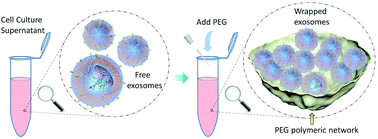Effective isolation of exosomes with polyethylene glycol from cell culture supernatant for in-depth proteome profiling†
Abstract
Exosomes are secreted nanovesicles shed by almost all kinds of cells. Recently, increased interest has been focused on these extracellular vesicles as natural carriers transporting biological contents for intercellular communication. However, current isolation techniques, such as ultracentrifugation, are not convenient and often require specialized equipment. Herein, we describe a polyethylene glycol (PEG)-based approach, which could permit facile, low-cost and effective isolation of exosomes from cell culture supernatant. High-resolution electron microscopes clearly visualized the size and morphology of isolated exosome aggregates, implying the mechanism of PEG-based precipitation. Combined with tandem mass spectrometry analysis, 6299 protein groups encoded by 5120 genes were successfully characterized from HeLa cell culture supernatant, including numerous exosome proteins which could overlap 97% of the Top 100 exosome marker proteins recorded in the ExoCarta database, as well as a series of low-abundance cytokines and biomarkers. Furthermore, we found a higher ratio of neo-cleavage sites in proteins identified from exosomes compared with cellular proteins, revealing the potential roles of exosomes in accumulation and transportation of protein degradation intermediates.


 Please wait while we load your content...
Please wait while we load your content...